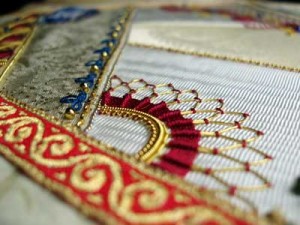Types of Hand Embroidery on Needle ‘n Thread
Crazy Quilting
 |
Crazy quilting can look to the Victorian era for its popular beginnings, and today, crazy quilting is certainly equally or more popular than it was 150 years ago. Crazy quilting sprang from a cross between necessity and the desire for beautifully embellished items of necessity. Irregular scraps of fabric were salvaged and re-made into quilts that were used for warmth, and to beautify the irregularity of the quilts made from scraps, the seams and squares were embellished according to the stitcher’s fancy.
Crazy quilting is certainly a free form of embroidery. Unlike most surface embroidery, this style of needlework is not dependent on any particular type of fabric, nor on any specific type of thread, nor any specific rules, really. All fabrics are game to the crazy quilter, and all threads and items of embellishment are part of the crazy quilter’s arsenal.
The ground for the needlework in crazy quilting is usually a patched quilt square made out of irregular shapes and sizes of fabric. The threads are many and varied – from cotton floss to pearl cottons, to silks, to wool, to … you name it! Ribbon embroidery is often employed. The stitches used in crazy quilting are really any stitches, in any combination that the stitcher wants to tackle. Bits of lace and ribbon, buttons, beads, and charms find their way into crazy quilt items as well.
Recently, crazy quilting has become a more precise art in the development of crazy quilted landscapes and images. For example, selecting fabrics that match the color of sky, earth, water, green fields, etc., the crazy quilter may piece together an image reminiscent of an Impressionist landscape. Then, using needle and thread, the crazy quilter adds dimension to the pieced fabric landscape by stitching in bark and leaves on trees, flower beds, texture in the sky, in the water, in the grass – all of which brings the landscape to life. The finished effect can be quite stunning.
Related posts:






